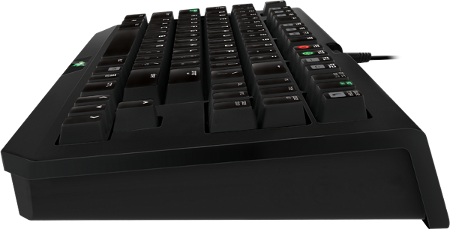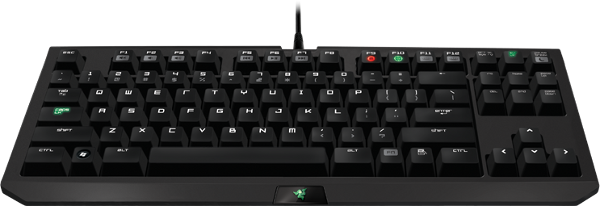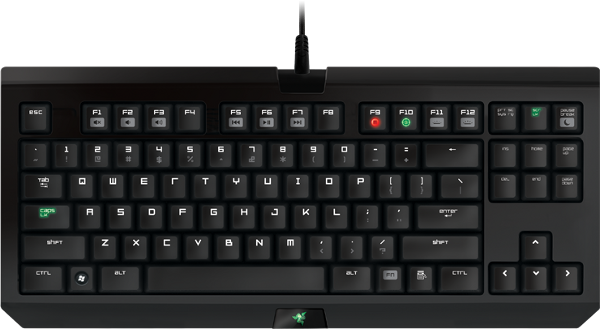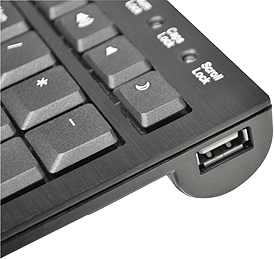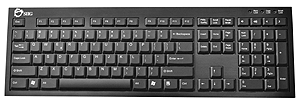Four Keyboards And Four Mice For LAN Party Gamers, Rounded-Up
We have four portable keyboards and a quartet of gaming mice that could turn heads at your next LAN party. We put the boards through a number of performance-oriented metrics, and handed the hardware off to some gamer friends for their opinions, too.
Razer BlackWidow And Siig JK-US0412-S1
Why you can trust Tom's Hardware
Razer BlackWidow Tournament Edition
Keyboards naturally tend to be pretty large and cumbersome, and the recent trend of going back to mechanical keyboards hasn’t helped keep their size in check. As a result, while full-sized mechanical keyboards generally have smoother, more responsive operation, only one was small enough to make it into this piece.
Razer, a well-known manufacturer of gaming-oriented peripherals, brings us the sole mechanical switch-based keyboard in this round-up: the BlackWidow Tournament Edition. In theory, the result is a lower possibility of ghosting, higher key rollover, and direct tactile feedback of activation.
The BlackWidow uses a Cherry MX Blue mechanical switch, which produces a subtle tactile confirmation when keys are triggered. This is noticeable to the typist about half-way through the depression of each key, where there's a bit of resistance, followed by a satisfying audible click.
Razer claims that this feedback gives players a clear sense of when the key triggers, which can help step up in-game performance. I'm not sure if I agree with that last part, personally; when I used the BlackWidow, I actually didn't do as well in my favorite games, feeling as if I had lost something.
The BlackWidow Tournament Edition occupies an odd position in Razer’s keyboard line-up; it’s much smaller than other BlackWidow models, and loses a number pad and key backlighting. Depending on the game you're playing and the environment you're in, those omissions may or may not be a problem.
Much of the hardware that Razer sells is over-the-top, with a mark-up to match. However, at an MSRP of just $80, the BlackWidow Tournament Edition seems to represent an exception to that rule.
Siig JK-US0412-S1
Our fourth and final keyboard is a bit more consumer-focused. An aluminum chassis puts Siig's JK-US0412-S1 on the heavier side of slim-profile keyboards, though its standard membrane matrix somewhat mitigates the additional shell weight. A sleek and modern minimalist design translates to fewer additional features; the one notable extra is a single USB port built in to the right side.
The keys have an oily sheen that reminds me of a glossy plastic console in a brand-new car, and their texture is pretty similar, too. With a center plateau and gently sloped sides, the Siig’s keys are somewhat reminiscent of an early 90s laptop board.
Based on the other keyboards we're reviewing, at $110, this product is on the expensive side. You're really shelling out the extra money for a product that feels sturdy. Ultimately, though, the feeling of quality doesn’t seem to translate into actual performance. If you have an aluminum fetish, this might be your thing. Just be sure to check out our comparison results for some less-than-stellar benchmark measurements.
Current page: Razer BlackWidow And Siig JK-US0412-S1
Prev Page Kensington K72357US And Logitech K800 Next Page Results: Volume And Activation ForceGet Tom's Hardware's best news and in-depth reviews, straight to your inbox.
-
atavax i wonder at what dpi's they tested acceleration. It was my understanding that a lot of mice have acceleration issues at different dpi's. I have seen multiple sources that say the G9 has negative acceleration at low sensitivities.Reply -
Trewyy G9x now down to $55 on Newegg :) I should mention that it was a good review, as always!Reply
http://www.newegg.com/Product/Product.aspx?Item=N82E16826104261 -
ShadyHamster ReplyFive programmable buttons near the thumb rest, a mechanical button below the scroll wheel, and a battery indicator set the G500 apart from standard mice.
That should be DPI indicator not battery.
And whats up with pitting 1 mechanical keyboard up against 3 membrane keyboards? Before even reading the article i knew that the mechanical keyboard would be the clear winner, who would care about the loudness of the keys at a lan party, 99.9% of people would have headphones. -
Swordkd Before I bought my Razer mouse(Imperator 2012), I read reviews on newegg and decided to discount the issue that they seemed to be having. After a few months of use, the mice would start to double-click from a single "click". Sure enough, less than 6 months of light to moderate use, my mouse now suffers from this malady once out of every 20 clicks or so. Enough to annoy me.Reply
I will not recommend that brand mouse to anyone ever again. -
kitsunestarwind Logitech G9X is a fantastic mouse, been using mine since they first came out, never a complaint and has led to me having very sharp and accurate aim in games like BF3. Buy one it is worth it!Reply -
alidan das keyboard professionalReply
razor naga
that's my setup...
that said, sound and weight to press are not lower or higher is better... they are prefferences, i personally love the sound that a cherry blue makes and wish it was a bit louder because i make more sound on each key by bottoming them out apposed to activating the switch.
and weight, i hear it more often than not that for gaming heavier presses are better because its less likely to accidently activate.
now, impersonally just because of prior things i have had, i can never recommend razor... but at the same time i use a razor because i want that 12 key pad, and Logitech mouse is even smaller than the already small naga, and i cant get use to its bad form factor... its really the only razor anything i recommend just because there is no other competition that i can tell people to go with outside the small logitech and only if they have small hands.
also, i dont know if it was mentioned, but the razor keyboard from what i remember has such a strict policy, that if you remove a key cap, you void the warranty. there are story's of the s and j key switched, but because of razors warranty, they have to send it in and get it replaced that way, and its a razor product, you know it will fail... the keyboard doesn't have a mounting plate, so its more likely to fail than other mechanical keyboards because of the solder point stress before the keys naturally give out. -
blubbey 'The G500 was reported to be too long,'Reply
I know of course this is personal preference and everyone's different, but either their hands are small or mine are of reasonable size because I can almost cover the entire mouse (fingertips and base of my hand can just about hit the mouse mat at the same time). Unfortunately I don't have much else to compare it to, only random mice however it is larger than any I can remember, so I might just have larger than 'normal' hands.
Something else you might want to consider that others have found is that the scroll wheel is very 'light' to use. I'm indifferent about it seeing as I'm used to light scroll wheels but a few people have raised that point in reviews that I saw before buying it (~$45 on sale). I've also found that the weights are prety much useless, it's already quite a weighty mouse so an extra few grams really didn't matter for me.
